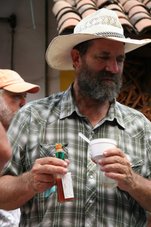
I have been working and
chatting (via email) with a friend, Larry
Littlefield -
KB7KMO, who is sailing around the South Pacific at the Marshall Islands in a 45 foot sail boat - The Sailing Vessel
KatieLee. Larry says;
he is eating his way around the world.
I asked Larry to try to listen to my
QRSS,
WSPR and
PropNet signals on 30m around 10.140
mHz from his location - so far nothing. Larry tells me that he downloaded
Spectran and ARGO to listen on the band, but again, so far nothing. Larry said that he is planning to replace his random length vertical with a Delta-loop - maybe he will get less noise and then be able to pick up the weak signals.
I asked Larry to key-down (actually mic key-down on AM) on 10.140100
mHz for about 10 seconds - I did not receive his signal here near Seattle.
We will plan more experiments, and maybe I will talk him into connecting up the remaining wires to his Transceiver so that he can participate in
WSPR to collect and provide spots.
Note: you can see Larry's
IP address on my Cluster Map - he is the single "dot" out in the South Pacific. You may ask - how did he get an Internet connection? He uses
WIFI from his Sail Boat to an Island shore and a local
WIFI hot spot - they charge him for his access.
You can read more about Larry's sailing adventures at:
http://svkatielee.blogspot.comThere will be more posted here about our attempts.











.JPG)



